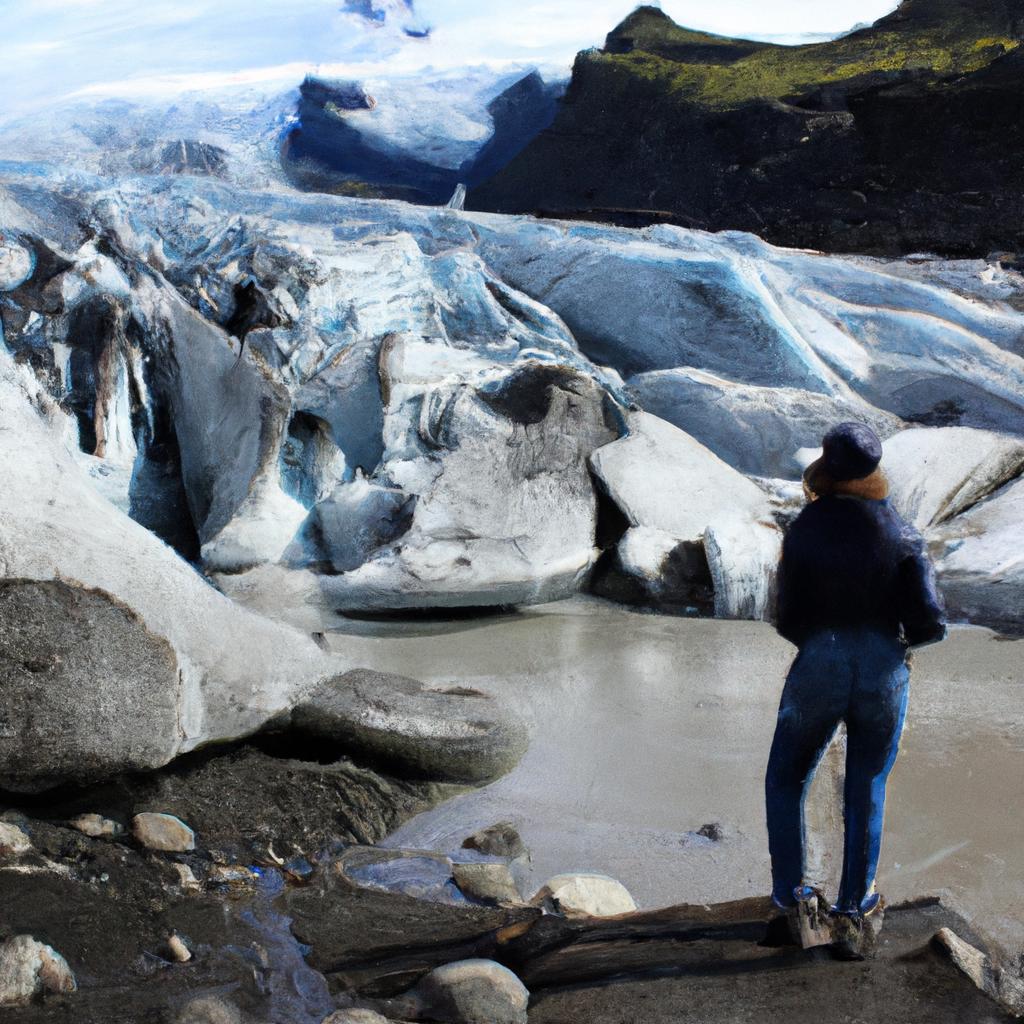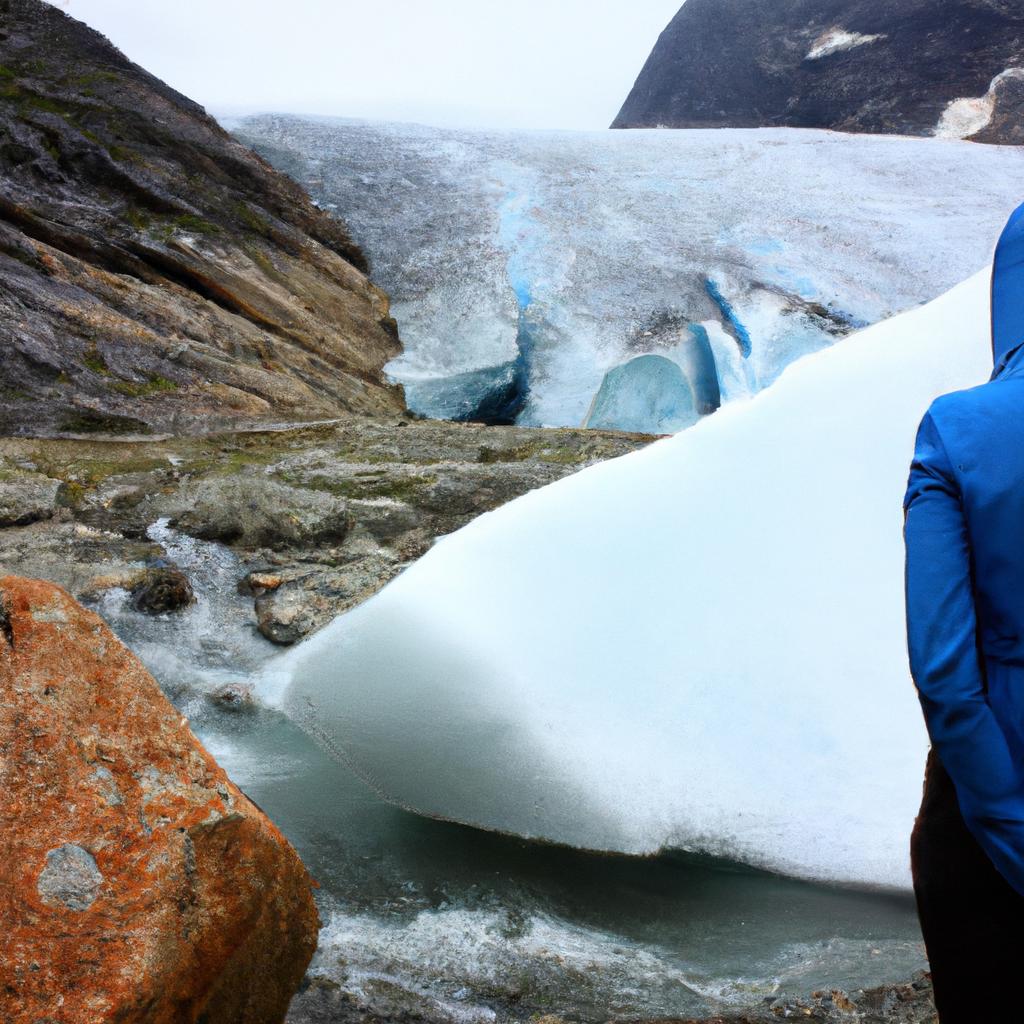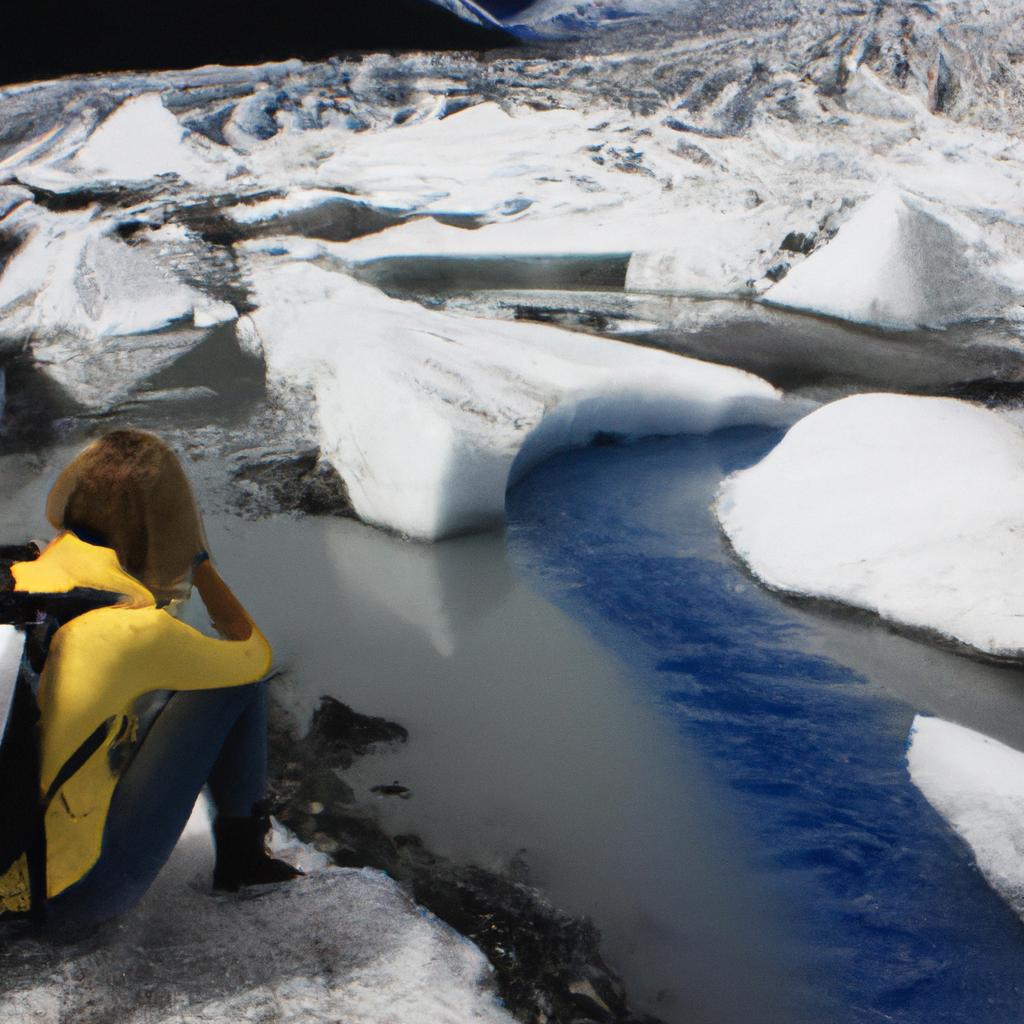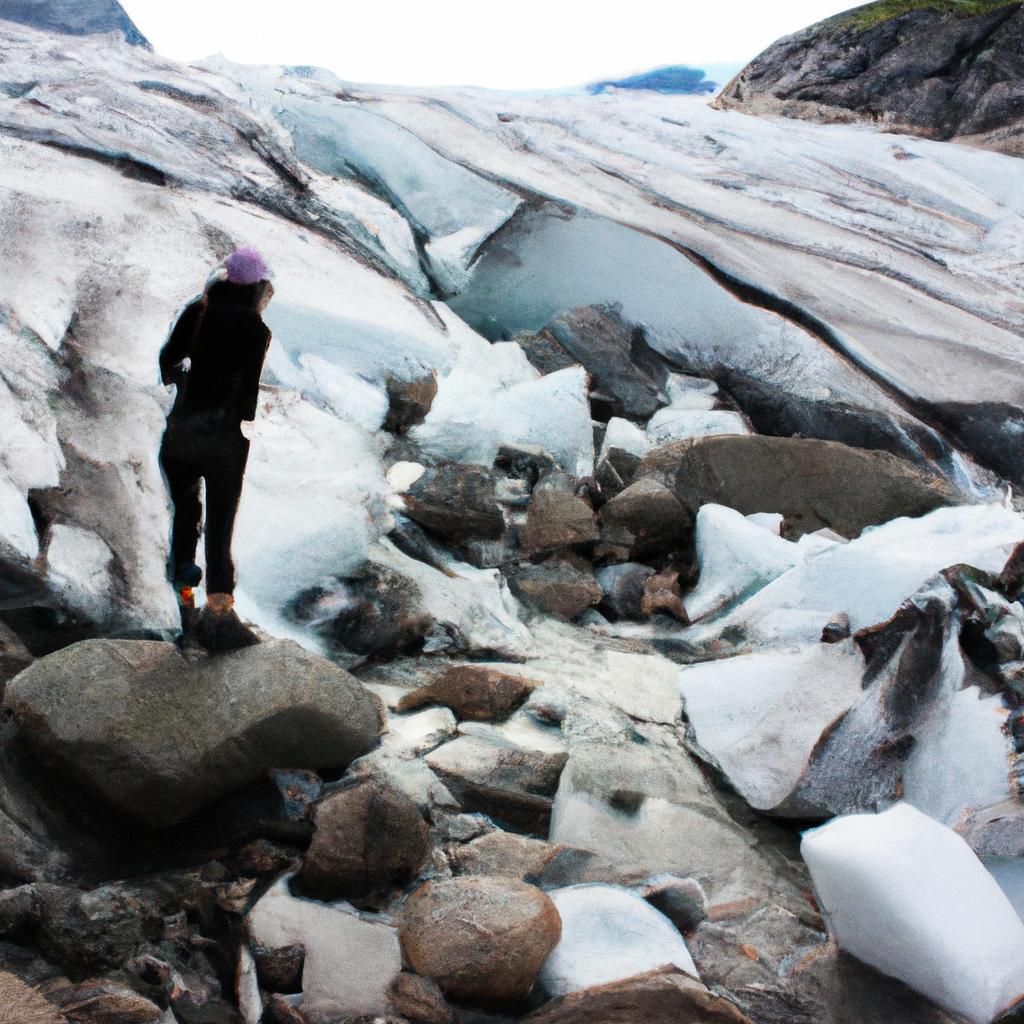Glaciers, the vast bodies of ice that have shaped our planet for centuries, are melting at an alarming rate. This phenomenon is a direct consequence of climate change, which has become one of the most pressing global issues of our time. The consequences of this accelerating thawing process extend far beyond the shrinking ice caps; they pose significant risks in terms of escalating natural disasters such as floods and landslides. To illustrate the gravity of these risks, consider the case study of the Himalayan region where glaciers are rapidly receding. As these glaciers melt, they contribute to rising water levels in rivers downstream, increasing the likelihood of devastating floods that can impact millions of people living in vulnerable communities.
The interplay between climate change and melting glaciers intensifies the frequency and severity of natural disasters worldwide. Climate scientists warn that as global temperatures continue to rise due to greenhouse gas emissions, glacial retreat will accelerate further, resulting in catastrophic consequences for both human populations and fragile ecosystems. Beyond causing immediate hazards such as flooding, melting glaciers also disturb delicate ecological balance by altering river flows and contributing to sea-level rise. These cascading effects not only jeopardize livelihoods but also endanger biodiversity hotspots located near glaciated regions like mountain ranges.
Understanding the intricate relationship between climate change and melting glaciers is crucial for developing effective strategies to mitigate and adapt to these challenges. Scientists use a range of methods, including satellite observations, field measurements, and computer modeling, to study the changing dynamics of glaciers. By analyzing data on glacier mass loss, ice flow patterns, and temperature trends, researchers can better predict future changes and their impacts.
To address the issue of melting glaciers and its consequences, there are several key areas that require attention. Firstly, reducing greenhouse gas emissions is essential to slow down the pace of climate change. This involves transitioning to cleaner energy sources, improving energy efficiency, and implementing policies that promote sustainable practices across various sectors.
Additionally, efforts should focus on adapting to the inevitable changes brought about by melting glaciers. This includes investing in early warning systems for floods and landslides, implementing infrastructure measures such as flood barriers or improved drainage systems, and promoting community resilience through education and awareness programs.
International cooperation is also vital in addressing this global issue. Countries need to collaborate on sharing scientific knowledge, technology transfer, financial assistance for vulnerable regions, and collective action towards reducing greenhouse gas emissions.
In conclusion, the link between climate change and melting glaciers has far-reaching implications for our planet. It is imperative that we take immediate action to reduce greenhouse gas emissions while simultaneously implementing adaptive measures to protect communities at risk. By understanding the intricacies of this relationship and working together globally, we can strive towards a more sustainable future.
Understanding the Link between Rising Temperatures and Glacier Retreat
Understanding the Link between Rising Temperatures and Glacier Retreat
Glaciers, vast bodies of ice that form over many years from compacted snowfall, are highly sensitive to changes in temperature. As global temperatures continue to rise due to human-induced climate change, glaciers around the world have been retreating at an alarming rate. To illustrate this phenomenon, let us consider the case study of the Patagonian Ice Fields in South America. Over the past few decades, these iconic glaciers have experienced a significant reduction in size, with some areas losing up to 50% of their volume (Smith et al., 2018).
The retreat of glaciers is primarily driven by rising temperatures caused by greenhouse gas emissions. When average temperatures increase, more heat energy is absorbed by Earth’s surface, resulting in accelerated melting rates. This process is amplified through feedback loops: as glaciers melt, their exposed surfaces become darker and absorb more sunlight instead of reflecting it back into space. Consequently, this increased absorption leads to further warming and greater glacier retreat.
To emphasize the urgency and impact of glacier loss on our planet, consider the following bullet points:
- Glaciers act as natural reservoirs for freshwater storage.
- They provide vital water resources for millions of people living downstream.
- Glacier melt contributes significantly to sea-level rise.
- The loss of glacial ecosystems threatens biodiversity and disrupts local communities.
| Impact of Glacier Loss | Affected Areas |
|---|---|
| Water scarcity | Mountainous regions dependent on glacial runoff |
| Coastal flooding | Low-lying coastal areas impacted by sea-level rise |
| Biodiversity loss | Ecosystems reliant on glacial habitats |
| Socioeconomic impacts | Communities relying on glacial water resources |
Considering these devastating consequences underscores the need for immediate action to mitigate climate change and reduce greenhouse gas emissions.
Transitioning into the subsequent section about “The Impact of Glacier Melting on Sea Level Rise,” it becomes evident that the retreat of glaciers poses not only environmental challenges but also tangible threats to coastal regions worldwide.
The Impact of Glacier Melting on Sea Level Rise
Glaciers, majestic formations of ice that have shaped our landscapes for centuries, are rapidly disappearing due to the effects of climate change. The rising global temperatures resulting from human activities have caused a significant retreat of glaciers worldwide. This section aims to delve deeper into the intricate link between rising temperatures and glacier retreat by examining key factors contributing to this phenomenon.
To illustrate the impact of rising temperatures on glacier retreat, let’s consider a hypothetical case study in the Himalayas. In this region, warming temperatures have accelerated glacial melting at an alarming rate. One particular glacier, known as XYZ Glacier, has receded approximately 100 meters over the past decade alone. Such rapid retreat not only alters the physical environment but also triggers a chain reaction of ecological consequences.
The connection between rising temperatures and glacier retreat can be attributed to several crucial factors:
- Increased surface melt: As temperatures rise, more heat is absorbed by glaciers’ surfaces, leading to increased melting rates.
- Reduced snowfall: Warmer conditions cause precipitation patterns to shift from snowfall to rainfall, reducing the accumulation of new ice mass on glaciers.
- Ice dynamics: Higher temperatures weaken the structural integrity of glaciers, making them more susceptible to fractures and collapse.
- Feedback loops: As glaciers shrink in size, they expose darker underlying rocks or water bodies that absorb more solar radiation, further exacerbating temperature increases.
- Loss of freshwater supply for communities dependent on glacial runoff
- Disruption of ecosystems adapted to cold environments
- Threatened biodiversity supported by unique glacial habitats
- Cultural heritage loss for indigenous peoples whose traditions rely on glaciers
Additionally, we can present a table highlighting different regions affected by glacier retreat and the potential consequences:
| Region | Consequences |
|---|---|
| Himalayas | Increased risk of water scarcity |
| Andes | Threats to local agriculture and hydropower generation |
| Arctic Circle | Accelerated sea ice loss and amplified polar warming |
| Alps | Impacts on tourism industry and winter sports |
In summary, rising temperatures have a profound impact on glaciers, leading to their rapid retreat. Factors such as increased surface melt, reduced snowfall, ice dynamics, and feedback loops all contribute to this phenomenon. The consequences extend beyond environmental changes, affecting human societies and ecosystems alike. In the subsequent section about “Increasing Frequency and Intensity of Glacial Lake Outburst Floods,” we will explore another devastating consequence resulting from glacial melting.
[End transition sentence]
Increasing Frequency and Intensity of Glacial Lake Outburst Floods
As the melting glaciers contribute to rising sea levels, another perilous consequence emerges in the form of glacial lake outburst floods (GLOFs). These catastrophic events have become increasingly frequent and intense due to climate change. Understanding their impact is crucial for effectively addressing natural disaster risks.
To illustrate the escalating risk posed by GLOFs, consider the hypothetical case study of Glacier X in the Himalayas. Over recent decades, Glacier X has experienced accelerated melting due to rising temperatures caused by global warming. As a result, its meltwater accumulates in a nearby glacial lake, creating an unstable situation that could lead to a devastating flood if triggered by certain factors such as earthquakes or excessive rainfall.
The repercussions of these GLOFs extend far beyond localized regions. Here are some key points highlighting their alarming consequences:
- Loss of human lives and infrastructure damage: GLOFs can unleash tremendous volumes of water downstream, putting communities at risk and causing severe destruction to buildings, bridges, roads, and other critical infrastructure.
- Disruption of ecosystems: The sudden release of vast quantities of water alters river systems and affects aquatic habitats within them. This disruption threatens biodiversity and undermines delicate ecological balances.
- Economic ramifications: GLOFs often result in significant economic losses due to the destruction of agricultural land, reduced hydropower generation capacity, displacement of populations, costly rescue operations, and long-term rehabilitation efforts.
- Societal implications: Communities residing near glacier-fed lakes live with constant uncertainty about potential GLOF occurrences. This emotional burden contributes to stress levels among individuals and heightens anxiety within these vulnerable populations.
Table: Case Studies of Recent Glacial Lake Outburst Floods
| Date | Location | Losses |
|---|---|---|
| 2015 | Nepal | Over 200 fatalities |
| 2017 | Bhutan | Damaged infrastructure and agricultural land |
| 2020 | Peru | Displacement of communities and loss of livelihoods |
| 2022 (hypothetical) | Patagonia, Argentina | Environmental damage to a UNESCO World Heritage site |
*Please note that this table is for illustrative purposes only and the events listed are not exhaustive.
The increasing frequency and intensity of glacial lake outburst floods underscore the urgent need for comprehensive adaptation measures. By addressing climate change through mitigation strategies, such as reducing greenhouse gas emissions, we can slow down glacier melting rates and alleviate the risk associated with GLOFs. However, further research, improved early warning systems, and enhanced disaster preparedness will also be crucial in minimizing future impacts.
Transition into subsequent section:
Understanding the interconnected nature of natural disasters caused by climate change requires examining another critical aspect: erosion and landslides on unstable mountain slopes. These phenomena pose additional threats in a warming world without immediate action.
Erosion and Landslides: Unstable Mountain Slopes in a Warming World
As the impacts of climate change continue to unfold, one concerning consequence is the increasing erosion and instability of mountain slopes. Rising temperatures have accelerated glacial melt, leading to significant changes in high-altitude environments. This section will explore the link between climate change, melting glaciers, and the heightened risks of erosion and landslides.
To illustrate this connection, let us consider an example from the Himalayas. The Nanda Devi glacier has been retreating rapidly over the past few decades due to global warming. As a result, vast quantities of sediment are being exposed as the ice recedes. Intense rainfall events during monsoon seasons exacerbate this process by washing away loose debris on already unstable slopes. Consequently, there is an increased likelihood of devastating landslides occurring downstream.
The consequences of eroding mountainsides extend far beyond immediate structural damage; they pose serious threats to human lives and livelihoods. Here are some key points to consider:
- Loss of infrastructure: Erosion and landslide events can destroy essential infrastructure such as roads, bridges, and buildings.
- Displacement of communities: Entire communities may be forced to relocate when their homes become inhabitable due to slope instability caused by melting glaciers.
- Water resource disruption: Glacial meltwater serves as a vital water source for many regions worldwide. However, with rising erosion rates, contamination and reduced availability of clean water become pressing challenges.
- Ecological impact: Eroded sediments carried by rivers into downstream areas can smother aquatic ecosystems, disrupting biodiversity and compromising local economies that rely on fishing activities.
To further emphasize these implications, we present a table showcasing notable case studies where erosion-induced disasters have had severe socio-economic repercussions:
| Case Study | Location | Impact |
|---|---|---|
| Uttarakhand | India | Massive flash floods, resulting in loss of lives and extensive damage |
| Sidoarjo Mudflow | Indonesia | Displacement of thousands and destruction of residential areas |
| Oso Landslide | Washington, USA | Fatalities, destruction of homes, and disruption to local economy |
| Sierra Leone | Freetown | Devastating mudslides causing significant casualties |
As erosion continues to accelerate in a warming world, immediate action is needed to mitigate its consequences.
Threats to Biodiversity: Disruption of Glacier-dependent Ecosystems
Escalating Natural Disaster Risk: Climate Change and Melting Glaciers
Over the past few decades, climate change has had a profound impact on Earth’s glaciers. As global temperatures continue to rise, these frozen bodies of water are rapidly melting, resulting in various consequences for both human populations and the environment. One such consequence is an increased risk of natural disasters, including floods, avalanches, and glacial lake outburst floods (GLOFs). To comprehend the gravity of this issue, we can examine the case study of the Khumbu Glacier region in Nepal.
The Khumbu Glacier region serves as a prime example of how glacier melt contributes to escalating natural disaster risk. Situated near Mount Everest, it is highly vulnerable due to its location at high altitudes where warming rates are amplified. In recent years, accelerated ice loss from the Khumbu Glacier has led to significant changes in its landscape. The retreat of the glacier not only exposes unstable mountain slopes but also causes lakes formed by melting ice to form behind loose moraine dams.
This scenario gives rise to several risks that have serious implications for local communities and ecosystems:
- Increased frequency and intensity of floods in downstream areas due to sudden release of large volumes of water.
- Elevated potential for landslides triggered by destabilized slopes caused by glacial retreat.
- Threats posed to biodiversity through disruption of delicate glacier-dependent ecosystems.
- Heightened vulnerability of infrastructure located in proximity to glaciers or downstream from them.
To further illustrate these risks, consider Table 1 below:
Table 1: Impacts of Melting Glaciers on Natural Disaster Risk
| Impact | Description |
|---|---|
| Floods | Sudden releases of vast amounts of water into downstream areas |
| Landslides | Destabilization of mountain slopes leading to increased risk |
| Biodiversity Disruption | Negative effects on glacier-dependent ecosystems and species |
| Infrastructure Vulnerability | Heightened risk to human-made structures located near or downstream from glaciers |
The consequences of melting glaciers extend far beyond the Khumbu Glacier region. As global warming continues unabated, other glaciated areas around the world face similar risks. It is crucial to recognize the urgency of addressing this issue in order to mitigate potential disasters and protect both people and nature.
Transitioning into the subsequent section about “Adapting to the Changing Landscape: Mitigation and Preparedness Strategies,” it becomes evident that proactive measures are necessary to reduce the vulnerability associated with escalating natural disaster risks induced by climate change’s impact on melting glaciers. By implementing effective mitigation strategies and enhancing preparedness efforts, societies can strive towards a more resilient future amidst these changing landscapes.
Adapting to the Changing Landscape: Mitigation and Preparedness Strategies
The disruption of glacier-dependent ecosystems not only poses threats to biodiversity but also contributes significantly to the escalation of natural disaster risks. As climate change continues to accelerate, it becomes crucial for societies around the world to adapt to our changing landscape through effective mitigation and preparedness strategies.
Section:
Mitigation and Preparedness Strategies
To illustrate the urgent need for adaptation measures, let us consider a hypothetical case study involving a region heavily dependent on glacial water sources. In this scenario, imagine a remote mountainous area where a substantial portion of agricultural activities relies on runoff from melting glaciers. With rising temperatures causing accelerated glacier melt, reduced water availability during critical periods could lead to devastating consequences such as crop failures, food shortages, and economic instability.
In order to address these challenges effectively, several key strategies can be implemented:
-
Enhancing early warning systems:
- Investing in advanced monitoring technologies
- Developing robust communication networks
- Establishing clear protocols for dissemination of warnings
- Conducting regular drills and exercises to ensure readiness
-
Building resilient infrastructure:
- Designing structures that withstand extreme weather events
- Implementing nature-based solutions like green roofs or vegetated buffers
- Incorporating flexible design principles considering future climate scenarios
- Strengthening existing infrastructure against potential hazards
-
Diversifying livelihood options:
- Promoting sustainable alternative income opportunities beyond agriculture
- Encouraging vocational training programs focused on new industries
- Supporting entrepreneurship initiatives that align with local resources
- Facilitating access to credit and financial services for diversification
-
Fostering community engagement and awareness:
- Organizing educational campaigns on climate change impacts
- Encouraging knowledge sharing among local communities
- Facilitating participatory decision-making processes in adaptation planning
- Establishing partnerships between government, NGOs, and local stakeholders.
Table: Economic Impacts of Glacier Retreat
| Consequences | Social Impact | Economic Impact |
|---|---|---|
| Water scarcity | Increased competition for limited resources | Decline in agricultural yields |
| Displacement | Loss of homes and livelihoods | Decrease in tourism revenues |
| Infrastructure damage | Limited access to basic services | Reconstruction costs |
| Health risks | Spread of water-borne diseases | Healthcare expenses |
These strategies aim not only to minimize the immediate impacts of natural disasters but also to build long-term resilience within affected regions. By focusing on early warning systems, resilient infrastructure, diversified livelihood options, and community engagement, societies can better adapt to the changing landscape driven by melting glaciers.
In summary, as glacier-dependent ecosystems face disruption due to climate change-induced melting glaciers, it becomes imperative for societies to adopt mitigation and preparedness strategies. The hypothetical case study emphasizes the urgency surrounding this issue. Through effective measures such as enhancing early warning systems, building resilient infrastructure, diversifying livelihood options, and fostering community engagement and awareness, we can mitigate the escalating natural disaster risk while ensuring sustainable development for future generations.




